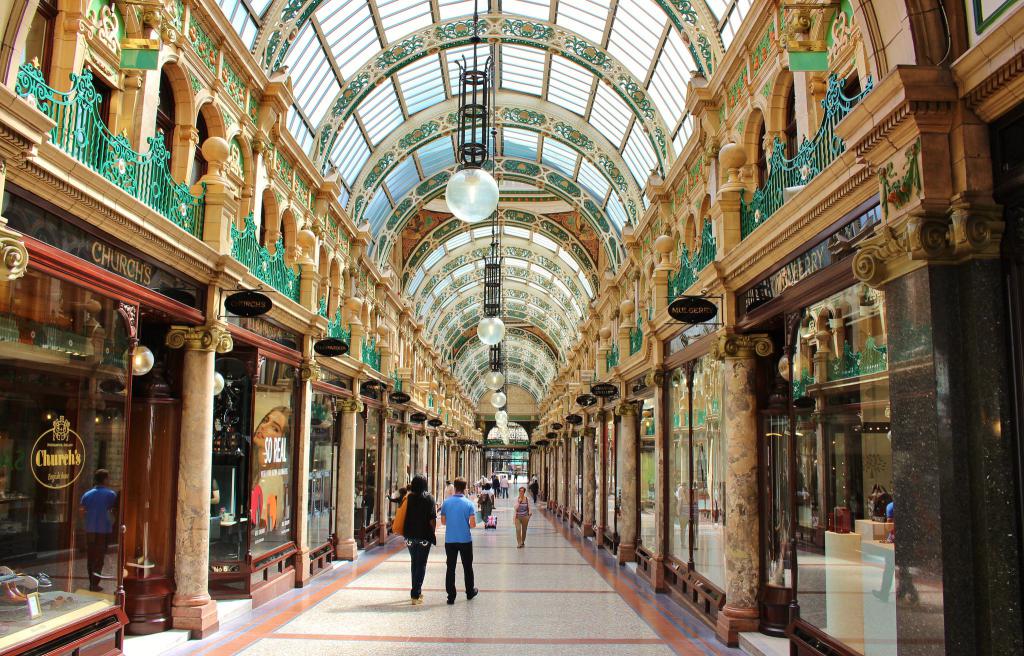Leeds is renowned for its Victorian and Edwardian arcades, which are among the finest in the UK. These arcades are more than just shopping spaces—they are architectural gems filled with ornate ironwork, stained glass, mosaic floors, and elegant boutiques. Together, they form one of the most distinctive features of Leeds city centre and contribute to its reputation as a leading shopping destination in northern England.
Here’s a guide to the main arcades in Leeds:
1. Thornton’s Arcade (Opened 1878)
- Location: Between Briggate and Lands Lane
- Architectural style: Gothic Revival
- Notable features:
- Leeds’s first covered arcade
- A dramatic red-brick façade and cast-iron detailing
- A famous automaton clock (by Potts of Leeds), featuring characters from Ivanhoe, including Richard the Lionheart and Friar Tuck
Thornton’s Arcade houses independent shops, stylish cafes, fashion boutiques, and specialist retailers. It’s narrow, atmospheric, and beautifully preserved.
2. Queen’s Arcade (Opened 1889)
- Location: Connects Briggate and Lands Lane
- Architectural style: Victorian elegance
- Notable features:
- Tall arched glass ceiling
- Ornate columns and detailed plasterwork
- Period charm with a mix of independent and high-street shops
It was originally built on the site of the Rose and Crown Inn. The arcade is light-filled, elegant, and often quieter than the busier streets outside.
3. Grand Arcade (Opened 1897)
- Location: Between Vicar Lane and New Briggate
- Architectural style: Edwardian Baroque with Art Nouveau influences
- Notable features:
- A stunning façade with floral details
- A unique turret clock with a set of mechanical figures
- Refurbished into a home for independent businesses, cafes, restaurants, barbers, and quirky shops
The Grand Arcade has become popular with creatives and locals looking for alternative and vintage offerings. It retains its original tiling and beautiful skylights.
4. Victoria Quarter (Late 19th Century, refurbished 1990s)
- Arcades included:
- County Arcade
- Cross Arcade
- Queen Victoria Street (glass-roofed street, not an original arcade but designed in harmony with the rest)
- Location: Between Briggate and Vicar Lane
- Architect: Frank Matcham
- Notable features:
- The most opulent arcades in Leeds, sometimes called the “Knightsbridge of the North”
- Luxurious mosaic flooring, marble columns, stained glass ceilings
- Home to designer brands like Louis Vuitton, Mulberry, and Harvey Nichols
- Features the largest stained glass roof in Europe (on Queen Victoria Street)
These arcades were part of the Victoria Leeds development and represent the finest examples of Victorian commercial architecture in the city.
5. The Light (Modern reinterpretation)
- Location: The Headrow, near Leeds Art Gallery
- Not a traditional Victorian arcade, but a contemporary leisure and shopping complex with covered walkways, boutique shops, restaurants, and a cinema.
6. Central Arcade (Less well-known)
- Location: Off Briggate
- Smaller and simpler than the other arcades but still part of the historic fabric of Leeds shopping arcades
- Houses a few retailers and is often overlooked by visitors focused on the more ornate arcades nearby.
Summary Table
| Arcade | Opened | Architectural Style | Known For |
|---|---|---|---|
| Thornton’s Arcade | 1878 | Gothic Revival | First Leeds arcade, Ivanhoe clock figures |
| Queen’s Arcade | 1889 | Victorian elegance | Arched glass roof, stylish shops |
| Grand Arcade | 1897 | Edwardian Baroque | Indie shops, turret clock, floral façade |
| County Arcade | 1898–1904 | Lavish Victorian/Edwardian | Marble, mosaics, stained glass |
| Cross Arcade | 1903 | Opulent Victorian | Links Victoria Quarter to Queen Victoria St. |
| Queen Victoria Street | 1990 | Modern glass canopy | Largest stained glass roof in Europe |
| Central Arcade | early 1900s | Simplistic Victorian | Smaller, less ornate |

